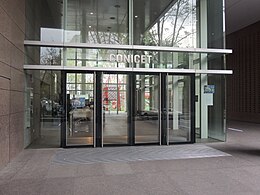Conseil national de la recherche scientifique et technique
| Fondation |
|---|
| Sigle |
(en) CONICET |
|---|---|
| Type |
Conseil national de recherche |
| Domaines d'activité | |
| Pays | |
| Coordonnées |
| Organisation mère |
Ministry of Science, Technology and Productive Innovation. (en) |
|---|---|
| Site web |
(es) www.conicet.gov.ar |
| TVA européenne |
|---|
Le Conseil national de la recherche scientifique et technique (en espagnol : Consejo Nacional de Investigaciones Científicas y Técnicas, sigle CONICET ) est une agence gouvernementale argentine qui dirige et coordonne la plupart des activités de recherche scientifiques et techniques effectuées dans les universités et instituts.
Historique
[modifier | modifier le code]Le Conseil national de la recherche scientifique et technique a été créé le 5 février 1958 par un décret gouvernemental. Son premier directeur fut le lauréat du prix Nobel de physiologie ou médecine Bernardo Houssay.
Fonctionnement
[modifier | modifier le code]Le Conseil est dirigé par un directoire indépendant du gouvernement fédéral. Il finance la recherche scientifique de trois manières.
- Il accorde des subventions pour des travaux collectifs à des équipes de recherche composées de scientifiques reconnus de toutes les disciplines, y compris les sciences sociales et humaines.
- Il compte en propre environ 6 500 chercheurs et 2 500 techniciens employés dans différentes catégories, allant de l'investigador asistente (chercheur assistant) à l'investigador principal (chercheur principal).
- Il accorde des bourses d'études doctorales et postdoctorales à 8 500 jeunes chercheurs d'Argentine et d'autres pays.
Classement
[modifier | modifier le code]En 2024, le CONICET est classé première parmi les institutions de recherches gouvernementales d'Amérique latine par le classement des institutions Scimago [1] et troisième parmi les institutions de recherche régionales après l'Université de São Paulo et l'Université nationale autonome du Mexique[2].
Anciens membres notables
[modifier | modifier le code]- Carlos J. Gradin
- Horacio Casini
Voir aussi
[modifier | modifier le code]- INAPL (en), Institut national d'anthropologie et de pensée latino-américaine destinée à la préservation du patrimoine culturel et archéologique national, organisme gouvernemental qui travaille avec le CONICET
Références
[modifier | modifier le code]- (en) Cet article est partiellement ou en totalité issu de l’article de Wikipédia en anglais intitulé « National Scientific and Technical Research Council » (voir la liste des auteurs).
- « Scimago Institutions Rankings », www.scimagoir.com
- « Scimago Institutions Rankings », www.scimagoir.com
Liens externes
[modifier | modifier le code]
- (es) Site officiel
- Ressources relatives à la recherche :
- (es) Site officiel
- Condiciones para acceder a una beca y a la carrera
Text is available under the CC BY-SA 4.0 license; additional terms may apply.
Images, videos and audio are available under their respective licenses.



